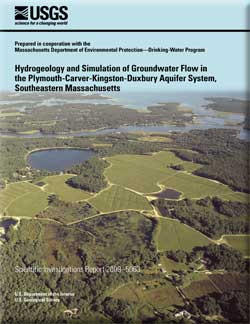
Product Details
- Product Number
- 116696
- Series
- SIR-2009-5063
- Scale
- NO SCALE
- Alternate ID
- SIR-2009-5063
- ISBN
- 978-1-4113-2433-6
- Authors
- ANDREW J MASSEY (CONTRIBUTING)
- Version Date
- 01/01/2009
- Regions
- MA
- Countries
- USA
- Media
- Paper
- Format
- Bound
Additional Details
- Description
-
ABSTRACT
The glacial sediments that underlie the Plymouth-Carver-Kingston-Duxbury area of southeastern Massachusetts compose an important aquifer system that is the primary source of water for a region undergoing rapid development. Population increases and land-use changes in this area has led to two primary environmental effects that relate directly to groundwater resources: (1) increases in pumping that can adversely affect environmentally sensitive groundwater-fed surface waters, such as ponds, streams, and wetlands; and (2) adverse effects of land use on the quality of water in the aquifer. In response to these concerns, the U.S. Geological Survey, in cooperation with the Massachusetts Department of Environmental Protection, began an investigation in 2005 to improve the understanding of the hydrogeology in the area and to assess the effects of changing pumping and recharge conditions on groundwater flow in the Plymouth-Carver-Kingston-Duxbury aquifer system.
A numerical flow model was developed based on the USGS computer program MODFLOW-2000 to assist in the analysis of groundwater flow. Model simulations were used to determine water budgets, flow directions, and the sources of water to pumping wells, ponds, streams, and coastal areas.
Model-calculated water budgets indicate that approximately 298 million gallons per day (Mgal/d) of water recharges the Plymouth-Carver-Kingston-Duxbury aquifer system. Most of this water (about 70 percent) moves through the aquifer, discharges to streams, and then reaches the coast as surface-water discharge. Of the remaining 30 percent of flow, about 25 percent of the water that enters the aquifer as recharge discharges directly to coastal areas and 5 percent discharges to pumping wells.
Groundwater withdrawals are anticipated to increase from the current (2005) rate of about 14 Mgal/d to about 21 Mgal/d by 2030. Pumping from large-capacity production wells decreases water levels and increases the potential for effects on surface-water bodies, which are affected by pumping and wastewater disposal locations and rates. Pumping wells that are upgradient of surface-water bodies potentially capture water that would otherwise discharge to these surface-water bodies, thereby reducing streamflow and pond levels. The areas most affected by proposed increases in groundwater withdrawals are in the Towns of Plymouth and Wareham where more than half of the proposed increase in pumping will occur.
In response to an increase of about 7 Mgal/d of pumping, groundwater discharge to streams is reduced by about 6 cubic feet per second (ft3/s) (about 4 Mgal/d) from a total of about 325 ft3/s. Reduction in streamflow is moderated by an increase of artificial recharge from wastewater returned to the aquifer by onsite domestic septic systems and centralized wastewater treatment facilities. It is anticipated that about 3 Mgal/d of the 7 Mgal/d of increase in pumped water will be returned to the aquifer as wastewater by 2030.
Currently (2005) about 3 percent of groundwater discharge to streams is from wastewater return flow to the aquifer during average conditions. During drought conditions, the component of streamflow augmented by wastewater return flow doubles as wastewater recharge remains constant and aquifer recharge rates decrease. Wastewater return flow, whether as direct groundwater discharge to streams or as an additional source of aquifer recharge, increases the height of the water table near streams, thereby moderating the effects of increased groundwater withdrawals on streamflow.
An analysis of a simulated drought similar to the 1960s drought of record indicates that the presence of streams moderates the effects on water levels of reduced aquifer recharge. The area where water-table altitudes were least affected by drought was in the Weweantic River watershed in the Town of Carver. Water levels decreased by less than 2 feet from current average conditions compared to decreases of greater than 5 feet in the Town of Plymouth. In the Weweantic River watershed the effect of the drought was reflected in the 50-percent reduction in streamflow in the Weweantic River, rather than a large decrease in water levels. The water table in areas where ponds are drained by surface-water outlets or where large gaining streams are present appears to be less affected by droughts than the water table in areas where streams are not present or where streams go dry under drought conditions.
- Height In Inches
- 11.000
- Width In Inches
- 0.250
- Length In Inches
- 8.500
- Two Sided
- Yes
- Pieces
- 1
- Languages
- English




